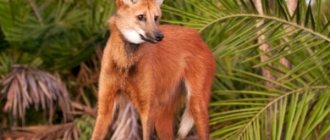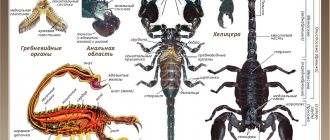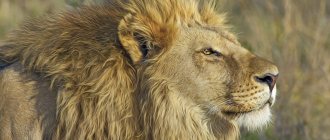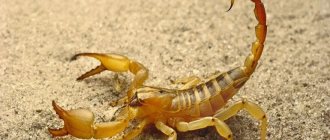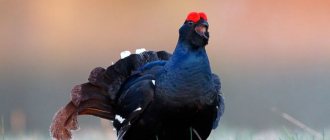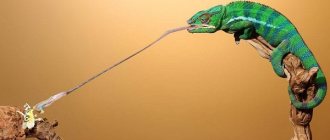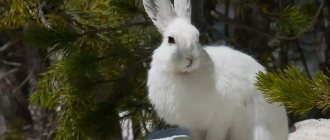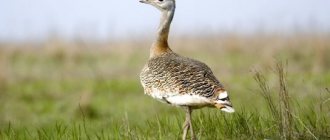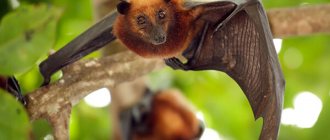Appearance
A wild rabbit is a small animal with a body length of up to 45 cm and a weight of up to 2.5 kg. A characteristic feature of the animal is that the length of its ears is always less than the size of its head, up to 7 cm, in contrast to hares, whose ears are longer. The feet of the rabbit's limbs are covered with short hair. The paws have long and straight claws.
The coat color of wild rabbits is predominantly gray-brown; in some individuals the reddish shade of guard hair predominates. The hair on the central part of the back is slightly darkened, the tail at the end is also dark, almost black or gray, and white underneath. The fur on the sides of the body is always slightly lighter than on the back, and in the abdominal area it is white or light gray. On the back of the head, behind the ears of the animal, there are ocher spots.
The fur of a wild rabbit does not change color during seasonal molting, which occurs in autumn and spring.
Internal structure
The skin of mammals is relatively thick, rich in skin glands - sweat, sebaceous, odorous glands. The presence of skin glands and hair provides perfect thermoregulation. The most characteristic of them are the mammary glands - modified sweat glands - which are found in females. The ducts of the mammary glands open in certain areas of the skin of the abdominal side. The milk secreted by these glands is sucked by newborn mammals.
Skeleton
The skeleton consists of the skull, spine, limb girdles and bones of paired limbs.
The mammalian skull is characterized by a large volume of the cranium, or braincase. Its bones fuse at the sutures quite late, so as the animal grows, the brain can increase in volume.
The spine consists of five sections: cervical (in all mammals it includes seven movably connected vertebrae), thoracic, lumbar, sacral and caudal. The ribs are attached to the vertebrae of the thoracic region; with their cartilaginous part they are connected to the chest bone, or sternum, forming the rib cage.
The sacral vertebrae are fused together and connected to the bones of the pelvic girdle. The number of caudal vertebrae ranges from 3 to 49. The degree of mobility of individual vertebrae varies. The vertebrae are the most mobile in small running and climbing animals, so their body can bend in different directions, curl up into a ball, etc.
The forelimb includes the shoulder, two bones of the forearm (ulna and radius) and the hand with five phalanges of the fingers.
The hind limb includes the femur, two tibia bones (large and small) and a foot with five phalanges. As a result of adaptation to different types of movement, the skeleton of the limbs in different mammals has changed greatly.
The musculature is very differentiated and complex. Chewing and facial muscles reach high development. Only mammals have a dome-shaped diaphragm, a muscular wall that separates the chest and abdominal cavities. When the diaphragm lowers and rises, the volume of the chest changes and intensive ventilation of the lungs occurs.
Where do rabbits live in the wild?
Wild European rabbits are native to Southern Europe, where they get their name. Over time, their habitat expanded significantly. The largest number of species lives in North America. In second place are the countries of South America. Wild rabbits live in Africa, western and central Europe, Scandinavian countries, the Mediterranean, islands in the Pacific Ocean, and the Atlantic. They feel good in Australia and New Zealand, where there is a favorable climate in the summer, there are no droughts, and in the winter there is no snow cover.
Animals choose places with dense vegetation for their habitat. They settle in meadows, clearings with tall grass, and along ravines. Plants within reach serve as food for them. They prefer light soil because they have to dig their own holes.
The limit of the habitat of wild rabbits in the world
Wild rabbits, as a rule, choose to live in areas with temperate climatic conditions, where there are no harsh winters. Today, these animals are distributed throughout the planet, with the exception of the Arctic and Antarctic regions.
The border of habitat in Russia
Rabbits appeared in Russia a very long time ago. They are even mentioned in ancient chronicles, which say that the first animals were released onto the coastal territory of the Dniester and Dnieper, from where the long-eared animals migrated to the north and east of the country.
At the moment, large populations of wild rabbits have been registered in the North Caucasus, in the Stavropol and Krasnodar Territories, and the Rostov Region. The climate and natural conditions of these regions are ideal for the animals, and they successfully reproduce there.
Rabbit breeds for the Kaluga region
"Yukhnov-Krol" is a famous plant in the Kaluga region for the production of rabbit meat. Breeds are purchased mainly from abroad and bred on the territory of the enterprise. Species such as French Hiplus, California rabbit, and Soviet chinchilla are bred here.
In addition, the APANYUK & Co rabbit breeding farm operates in the region. Here they professionally breed rabbits of various types, maintaining the purity of the blood of the breeds. At this enterprise you can purchase breeding specimens of the White Giant, Californians, Burgundy rabbits, Ram, Chinchilla, Risen and the like.
Two types of burrows in rabbits
The dwellings of wild rabbits are of two types: simple and complex. Simple ones are disposable and are pulled out by pregnant females before giving birth, following instinct. There births and feeding of newborns with mother's milk take place.
A simple burrow, which is a tunnel with a diameter of 10-15 cm at the entrance, gradually widens and ends with a chamber intended for brood, with a diameter of 30-60 cm.
Families led by a dominant male live in complex, permanent burrows.
The family hole is complex. The length of the tunnels reaches 50 meters. There are numerous branches and several emergency exits. The height of the living quarters is 30-60 cm. You can detect the hole by the vegetation eaten around it.
Lifestyle
The European rabbit leads a sedentary lifestyle, unlike the hare. Animals inhabit territories with rugged terrain and rich vegetation, since the latter serves as food for them. Animals can be found on the coasts of estuaries, in ravines, and ravines. Animals are not found in dense forests, nor in mountainous areas.
Wild rabbits often coexist with humans, populating areas on the outskirts of populated areas, landfills and wastelands. Since rodents have a need to dig holes, the composition of the soil matters to them. For these animals, loose soil is preferable to clay or rocky soil. Having chosen a territory, the animals mark it with their secretions, rub their muzzles on objects, scatter excrement and splash urine. These animals prefer to live in small groups in which:
- the dominant role is given to the breeding male;
- a dominant female with cubs lives with him;
- the group includes 1-2 more females with or without offspring, living in separate burrows.
Young males living in the same colony with the dominant one readily protect females and offspring. Rabbits have their own methods of communication, they warn each other about danger, and come to each other's aid.
Wild rabbits are polygamous creatures, but some individuals create a family with one female and remain with her forever.
The burrows of wild rabbits are of interest. They are different:
- Family. Only adult animals live in them. Such dwellings are equipped with several entrances and exits.
- Broods. This type of burrow is intended for baby rabbits. Fled females independently dig them not far from the family burrow. Brood burrows have only 1 entrance, which also serves as an exit. Female rabbits come there to feed their babies. When leaving the nest, the female disguises the entrance so that wild animals do not find the offspring.
Family-type burrows can be simple or complex. The first are intended for single females, and the second for a dominant male with his family. Simple family burrows have up to 3 entrances and exits, and complex ones have up to 8.
What should a rabbitry be like?
A place for breeding rabbits in a country house or plot is a rabbitry, most often a wooden structure in the form of an old cabinet, which consists of individual wooden cages or the structure itself is divided into smaller cages.
Playpens are usually constructed of mesh and the animals are divided into groups.
Arrangement of the cage
The cells must be:
- dry,
- clean,
- light,
- sealed.
Outdoor cages should be covered - rabbits do not like rain, harsh light, and should not be kept in the sun.
To ensure effective urine flow, a double floor is made. The lower floor should be sealed and slightly sloping, the upper floor should be secured with slats spaced 1.5 cm apart. In winter, a large amount of bedding should be provided.
Rabbits require cages of the appropriate size. When choosing cells, you need to take into account the specialization of selection (skins/meat) and the breed of animals.
The figure shows the dimensions for keeping 1 rabbit. When keeping in groups, the cage size should be increased in proportion to the number of animals kept. It is optimal to keep 2-3 animals in a cage, which allows you to strengthen control in the herd, easily monitor diseases, and respond to aggressive behavior.
When raising rabbits for meat, it is better to keep them in large cages to ensure a lot of movement, which has a positive effect on the quality of the meat. It is important to group animals by breed, age, and gender. This prevents rabbit cannibalism and biting.
A large number of animals in a cage increases the number of pathologies by 15%, leading to excessive obesity of animals.
Adult males should be kept in separate cages or boxes. Each of them should have his own cage where he will feel safe. The male's cage should be located away from the females, the smell of which can stimulate the male to constant activity; he will waste energy unproductively, trying to get out of the cage. It is best to place the males' cages in a separate room or outdoors, away from the rest of the nursery. If this is difficult to do, cages should be placed to the side of a large group of cages or on the top floor.
The separation of animals is also aimed at limiting the spread of pathogens and the possibility of using a different feeding system.
Manure should be removed, cages cleaned, disinfected weekly, then re-lined with fresh straw. This will keep the animals healthy. Rabbit manure can be used as fertilizer.
Temperature, lighting, humidity
Animals need to be provided with:
- access to light
- optimal temperature,
- required humidity.
It is important to provide animals with good air access. If you are serious about rabbits, you will need summer and winter cages (located indoors).
Rabbits need access to natural or artificial light. Light is an important factor affecting the reproduction of rabbits. The cages need to be equipped with feeders, drinking bowls, and houses for females.
In winter, it is necessary to provide a large amount of bedding and access to light: 14-16 hours a day.
Optimal room temperature:
- for females with cubs – 18 g. C, as the animals grow, the temperature can be reduced;
- adult individuals can be kept at a temperature of 12-14 degrees C.
Humidity should be about 65%; too low humidity can cause dry mucous membranes, reducing the resistance of animals to diseases of the respiratory system.
Ventilation
Gravity ventilation and room ventilation are usually used. Ventilation serves to remove moisture and harmful gases that threaten the health of animals. It is important not to create drafts and that the cages do not stand in a direct line to the fresh air intake.
Nutritional Features
Wild rabbits are herbivores, adapted to life in regions with poor vegetation. Animals digest food with the help of cecotrophs, which contain many enzymes, amino acids, vitamins and beneficial bacteria.
They are formed in the cecum and, after exiting through the anus, are eaten, enter the intestinal canal and participate in the breakdown of cellulose.
In summer, European rabbits eat grass and leaves. In winter, their diet consists of branches and roots. European wild rabbits that live near farmers' fields feast on carrots, lettuce, cabbage, legumes and grains.
Rabbit breeds for Siberia
In Siberia and the Urals, only the hardiest breeds with thick, dense fur can be raised, which can protect animals from cold climates. In these areas the climate is harsh, there is often precipitation and strong winds. Animals are bred here en masse, mainly in the peasant farm “Tatyanin Khutor” and the private farm “Siberian Rabbit”.
Among the most preferred breeds for this region are: Siberian Eared Rabbit, Blue Vienna Rabbit, Rex, White Giant, California Rabbit.
Varieties of European rabbit
The European wild rabbit is the only representative of the domesticated rabbit from which modern breeds originated. The following species are found in the wild:
An ordinary rabbit. It lives in most European countries and other areas, with the exception of places with prolonged sub-zero temperatures.
The water rabbit is the largest representative of the genus. The length of the body reaches 55 cm. It is notable for the fact that it swims well and knows how to hide from pursuit under water. In this case, the nose remains on the surface, which allows the animal to remain in this position for a long time. They live in the southeastern states of the USA. Swampy lowlands are chosen for living.
Red rabbit. Habitat: highlands in southern Africa. A distinctive feature is the thin silky fur of a reddish color, tinged with gray. Long body, large ears covered with sparse hair.
The Idaho rabbit (pygmy) is the smallest rabbit in the world. Body length from 22 to 28 cm, weight 250-450 grams. Short hind limbs make it impossible to move by jumping, as its brothers do. The fur is yellowish-brown, lighter on the belly and paws. Lives in the northwestern states of the USA. It settles mainly in wormwood thickets, which is the main type of food.
Nutalla is a small animal. The body length is 33-40 cm. It has long hind limbs, the feet of which are covered with long hair. The main color is light brown. Lives in the USA and Canada.
California rabbit. The large animal reaches 50 cm in length. The legs, paws, ears, and tail are short. Color ranges from brown to dark brown. Lives on the Pacific coast of North America. Settles in areas overgrown with bushes. A distinctive feature is the ability to climb bushes and small trees in search of food.
Steppe rabbit. A characteristic external feature is large, vertical ears. With a body size of 33-43 cm, the length of the ears can reach 10 cm. The color is grayish-brown. Habitat: desert grasslands of North America and Mexico. They feed on cacti and herbs growing there.
Tailless or volcanic rabbit. One of the smallest species of wild rabbits. Body length 27-32 cm. Small rounded ears, tail almost invisible. Habitat: mountainous areas of central Mexico.
The most widespread is the common rabbit.
Possible diseases, vaccinations
Rabbits, like other domestic animals, are at risk of dangerous diseases. The most common are the following:
- Myxomatosis, which is a viral disease.
- Hemorrhagic viral disease is also caused by viruses.
In the first case, conjunctivitis appears in a special form in sick animals; painful bumps form throughout the body. When the disease occurs in an edematous form, this gives an almost one hundred percent probability of death.
If the disease occurs in a nodular form, then rabbits do not die from it. Moreover, in this case, treatment can be done.
Treatment of rabbits
However, one of the features of this disease is that... That it provokes various secondary diseases. In some cases, rabbits in this situation develop stomatitis.
Note! Myxomatosis viruses do not affect humans.
Hemorrhagic disease, according to scientists, is of Chinese origin. The first information about mass diseases of rabbits dates back to the eighties of the last century. Interestingly, small rabbits are not susceptible to this disease at all.
This disease is very secretive. Symptoms are difficult to calculate and can only be noticed with careful observation. Often leads to death in animals. Outwardly it looks like this: the rabbit makes several convulsive movements with its paws and dies.
Often death occurs so quickly that symptoms have not yet appeared during this time. The diagnosis is made on the basis of an autopsy of the deceased animal. In this case, hemorrhagic rashes can be found on internal organs. There is no known cure for this disease.
Signs of death unknown
One of the effective means of combating diseases is vaccination of rabbits. At the same time, they are given weakened pathogens, the body defeats them, and immunity is acquired for some time.
Newly born rabbits are vaccinated against these diseases. They are done in the following order:
- When the baby rabbit is 45 days old, he is given the first vaccination to combat hemorrhagic disease.
- After 14 days have passed, vaccination against myxomatosis is performed.
- A second vaccination to combat myxomatosis is performed after three months have passed from the first.
- After another 14 days, another vaccination is performed, which is aimed against hemorrhagic disease.
Important! Immunity after these actions occurs for six months. Therefore, for continuous protection, procedures must be repeated every six months.
When thinking about why a rabbit has hot ears, you need to understand that the cause may be a disease. It's best to take him to the vet.
Lifespan of wild rabbits
The biological age of rabbits living in the wild is 15 years, but in reality only 30% of rabbits survive until the age of three. This is due to the fact that there are a lot of predators and birds who want to hunt these defenseless animals. But the cause of early deaths is not only attacks from wild animals, but also various infections and diseases that a weak body cannot tolerate.
To date, the maximum recorded age for rodent life expectancy is 19 years. In the wild, rabbits do not live more than 2-3 years, which cannot be said about pets, whose life is completely dependent on their owner. Domestic rabbits can live up to 7 years.
Reproduction
If the female rabbit is a healthy female, then within a year she will bear quite a large offspring. If the female is obese, it will cost her that she will not be able to give birth.
Obese rabbit
However, this problem can be fixed. To do this, you need to adjust the rabbit’s diet. If you feed her greens and limit her consumption of grains and mixed feed, then after some time she will return to normal.
Typically, a female rabbit gives birth at least six times during this period. If you count the total number of rabbits that she gives birth to in a year, it is usually about 25 rabbits. When they become adults, the amount of meat that can be obtained from them will be approximately 70 kg.
Immediately after birth, rabbits need care. They become independent after three or four weeks. This is manifested in the fact that from now on they will be able to take not only milk, but also regular food. However, they still won’t refuse milk.
Note! Usually, the time during which children consume milk depends on how long the rabbit can give it to them.
You can easily determine how babies eat by assessing their appearance. If their skin is smooth and they behave calmly, then the rabbit has a lot of milk, and the rabbit’s temperature is normal. Otherwise there is not enough of it.
It is interesting that the female rabbit will not want to raise other people's cubs. The fact is that these furry animals, although they see poorly, have a good sense of smell. If you put someone else's rabbit on her, she will immediately recognize him by the smell.
In order to carry out mating, it is necessary to select females that are in good health and have high milk production. It is necessary not to use those rabbits that are known to eat their offspring.
Rabbit mating
Seasonality does not affect the reproduction processes of these animals.
What is the value of these animals for humans?
It turns out that only this species of European wild rabbit has been domesticated by humans. Therefore, he is considered the ancestor of all domestic breeds of these small animals without exception.
They are currently being bred in various natural protected areas and nurseries. European rabbits are in demand among many breeders, as they can be used to improve breeds of domesticated species.
In addition, they are a commercial object due to their beautiful fur and tasty meat. That is why rabbit breeding is considered one of the most important branches of world agriculture.
Since the domestication of wild rabbits, more than seventy different breeds of these animals have been bred. Among them are downy, decorative, and also those used for testing new medications and food products in scientific laboratories.
But besides being useful, these wild animals in some countries, where there are no predatory animals, can cause great harm to people, eating all crops, damaging fields, crops, and also spoiling land with their numerous burrows. For example, on the Pacific islands they completely destroyed vegetation, which led to soil erosion and the destruction of coastlines that served as nesting sites for seabirds.
Growing methods
You need to start breeding rabbits by choosing a breed and a method of keeping them. There are 3 growing systems depending on the available area, the number of people servicing the farm, and the financial capabilities of the breeder. Various growing methods are practiced:
- breeding rabbits in enclosures;
- in open-air cages;
- under a canopy;
- breeding in a pit;
- indoors, at home.
In cages, enclosures, and playpens, animals can be kept individually or in a group, with the rabbits of the main herd being kept alone upon reaching puberty. Some summer residents practice breeding rabbits in a pit; this is a fairly economical method; a pit measuring 2 × 2 m can accommodate many rabbits. There are advantages and disadvantages to being kept in a pit.
Outdoor cultivation
In open space, cells are placed in one or several levels. Childbirth takes place only in spring and summer, when the temperature is suitable for raising young animals. Rabbits are little sensitive to cold, worse for them:
- heat;
- direct sunlight;
- drafts.
Therefore, cells must be protected from sun, wind, and rain.
Growing on litter indoors
In a room or barn, bedding is poured on the floor, allowing animals to move freely and build nests before giving birth. Hay or straw is chosen as bedding, which provides additional food.
The method of growing on straw or sawdust is quite popular. This way the animal can keep its fur clean, since the hygroscopicity of sawdust absorbs most of the water. The only drawback is the need to frequently replace the bedding, which is associated with a large amount of work and the cost of purchasing sawdust and straw.
Growing in cages indoors
Rows of cages are installed, single or multi-story, made of wood and galvanized mesh. Multi-story cages should have sealed sheet metal or plastic floors angled toward the back of the cage to allow water to drain, and a wood, plastic, or mesh screen over the floor.



